The Best Reason to Visit Cleveland? To See a Dead Man
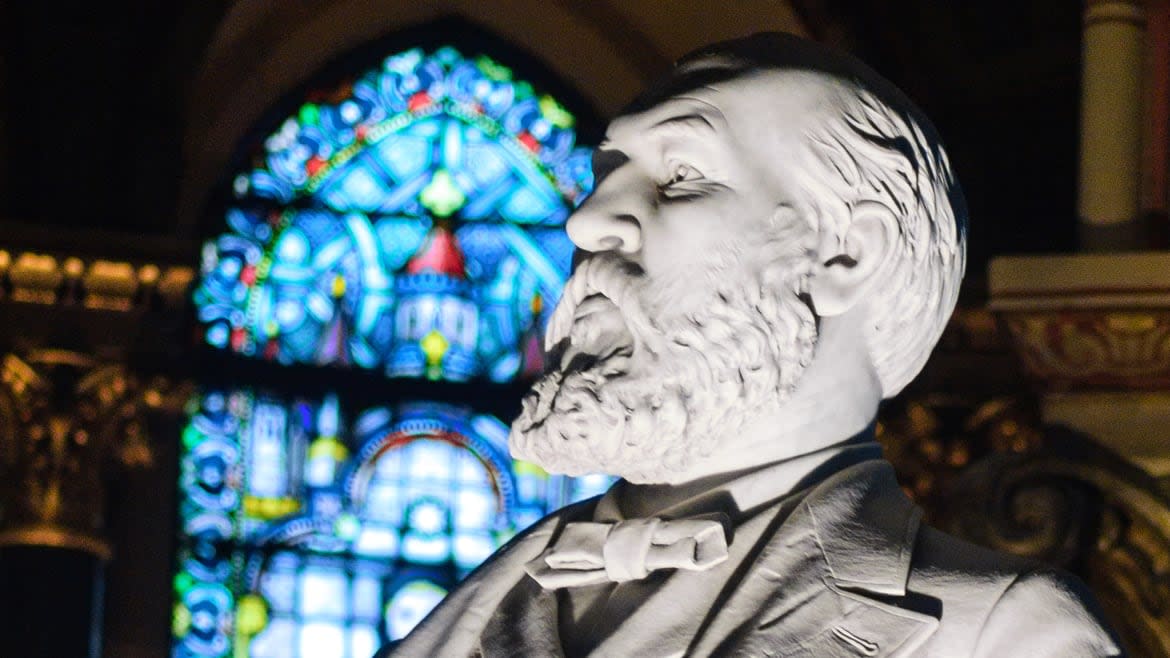
I came to Cleveland to see a dead man.
Not just any dead man, but a dead man whose gruesome death left America shaken and unsure of its new place as a stable world power—a dead man who probably has not crossed your mind more than once or twice.
On a grassy rise in Lake View Cemetery (a macabre carnival of sorts for the history nerd) an odd Victorian Gothic tower appears, crowned by a spire. I say odd not because it’s misshapen, but because while there are certainly any number of spectacular mausoleums in this scenic 285-acre expanse, this sandstone folly is more something one would expect to find in a country estate designed by H. H. Richardson. For those curious enough to venture in, it contains an outrageously over-the-top memorial and tomb filled with Murano glass mosaics, expensive marble, and lofty architectural details befitting a conquering European monarch à la Napoleon or the fatuous “grand” duke Medici.
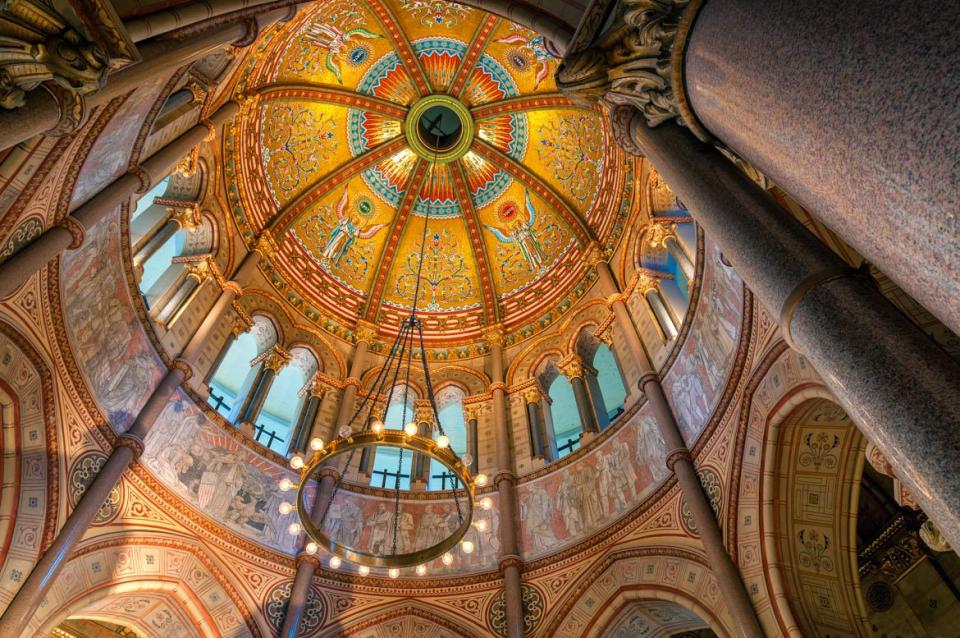
Instead it contains the remains and a soaring statue of the most forgettable of presidents (James Garfield) in the era of forgettable presidents (post-Reconstruction). Ask anybody to recite the presidents in order, and there are three periods that trip them up. Between Van Buren (Jackson, let’s be honest) and Lincoln. Between Wilson and FDR. And between Grant and McKinley. The last decades of the 19th century may have been the era that propelled the U.S. to what Henry Luce called the American Century, but its leaders were often caricatures of machine politics and corruption—pygmies masquerading as a colossus, as the late Robert Byrd might say.
Actually, maybe I’m being unfair to Garfield. He wasn’t the most forgettable (that goes to Hayes or Harrison). Instead, Garfield gets remembered because just four months after being inaugurated as president, he was shot in the back at the Baltimore and Potomac Railroad Station in Washington, D.C, which no longer exists and was where the National Gallery stands today. In a twist of fate, Abraham Lincoln’s son, Robert, who was Garfield’s secretary of war was a witness to the assassination by Charles J. Guiteau. (Although, wait, scratch that. Because if you’re playing the president assassination trivia game, Garfield is definitely the name that you can’t remember.) Then he suffers horribly for months as “doctors” attempting to save him rummaged around in his body for the bullet (including Alexander Graham Bell, who tried to use an early version of a metal detector) only to leave him even worse off from infection. All told, the self-made man who rose up from a log cabin to become leader of the nascent American world power spent a third of his presidency in a bed in unimaginable agonizing pain.
I was also in Cleveland because, I hate to admit, I really knew nothing about this city except it being the metropolis around which so much of American politics in the last century and a half has revolved.
Thus it seemed like an ideal candidate for a series we have at Beast Travel that I love—It’s Still a Big World. Twice a month we take our readers to a destination they’ve likely never considered and try to crack it open and reveals the wonders it may hold inside.
And, as I discovered this month, Cleveland certainly does have wonders.
Don’t get me wrong, it’s unlikely travelers from across the country or world are going to be journeying to Ohio just for Cleveland’s touristic offerings. But, if you happen to be there for work or health (Cleveland Clinic), considering where to stop on a northern cross-country road trip, or a history buff exploring mid-size American cities—there’s a lot here for you.
First, the two things essential for any urban destination worth your time—places to eat and sleep. As for eating, like many cities across the U.S. that coastal elites might have once blanched at dining in, Cleveland has upped its game in recent years. It has a number of James Beard Award-winning chefs, and a number of spaces throughout the city that nail good food and great ambiance. Two can’t-miss options that made my time memorable were Marble Room and The Plum.
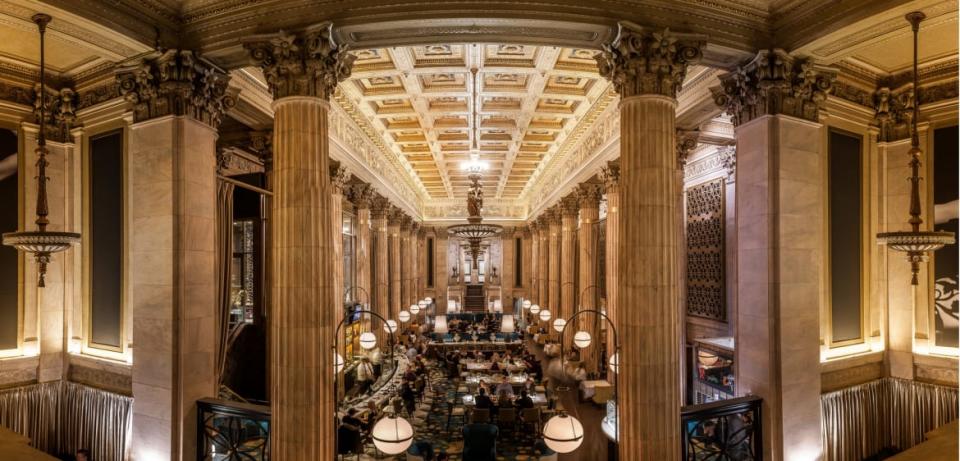
The interior of Marble Room.
Marble Room Steak and Raw Bar is the high-end dining spot in the jaw-dropping former National City Bank in the Garfield Building downtown. Think ornate coffered ceilings, hulking marble Corinthian columns, and underground vaults converted into private dining rooms. All you need to know is that in addition to being a gorgeous space, it nails the staples as I had fantastic oysters and wolfed down my cut of meat. (I do have one annoying quibble however. They’ve created this swanky space but the salt and pepper shakers front and center on every table look cheap.)
The Plum, located in lively Ohio City just across the river from downtown, is a must for those who like the combination of an inventive menu in a cute and playful space. I’d recommend starting with the kale sprouts, but the menu changes every couple weeks depending on what can be sourced from nearby farms.
The city also has a bevy of breweries and low-key fare. One of the best Reubens I’ve ever had were found here at Lox, Stock, and Brisket, and all the sandwiches I wolfed down at Larder were delicious. Those looking for hearty breakfast/brunch options won’t go wrong at Lucky’s Cafe over in Tremont, just a couple blocks from the iconic St. Theodosius Orthodox Cathedral. And of course no visit to Cleveland would be complete without a stop in its historic West Side Market in Ohio City.
As far as where to lay your head, there’s plenty of modern options from the Marriott at Key Center to the Hilton Downtown to the Ritz-Carlton, but one of the most fascinating things about Cleveland has been the rush in recent years to transform one-of-a-kind historic buildings into hotels. The Drury is in the former Board of Education building, the Kimpton in the former Scofield building, the Metropolitan at the 9 in a Breuer tower, and the Hyatt Regency in the truly jaw-dropping Arcade.
If there’s a social-media friendly show-stopper in Cleveland, it’s without a doubt the Arcade. Built in 1890 and financed by tycoons like John D. Rockefeller (Standard Oil was founded here), it was one of the earliest indoor malls in the U.S. and certainly one of its most glamorous. It is lined on both sides by five stories of completely reserved retail and crowned by a huge glass skylight running the length of the building. While it’s said to be inspired by the Galleria Vittorio Emanuele II in Milan, that’s a bit of a stretch as the Arcade screams turn-of-the-century American in its overall aesthetic.
In fact, Cleveland as a whole screams turn-of-the-century America. And when I say screams, I’m only exaggerating a little bit. Nearly every single person I interacted with reminded me that Cleveland was once the fifth-largest city in the U.S., and according to one study at that time had more self-made millionaires than any city in the world. (For those looking for an easily digestible walk-through of the city, the Cleveland History Center on former Millionaire’s Row is a great place to start.) Those millionaires left behind cultural treasures that many big cities around the world would kill for, including the world-class Cleveland Museum of Art that is free to the public. Two paintings any visitor should not miss, the photograph-like Twilight in the Wilderness by Frederic Edwin Church and my fiery favorite of J.M.W. Turner’s series The Burning of the Houses of Lords and Commons, 16 October 1834.
The crown jewel in its cultural collection however, has to be Severance Hall (built in 1931), home to the Cleveland Orchestra. Cleveland’s orchestra is perennially ranked one of the best in the world (as is its Music Institute, which performed Mahler’s Fifth when I was in town). And Severance Hall is, in a word, glorious. The only hint on the restrained exterior of the decorative explosion inside is the Art Deco pediment above the entrance. Inside, a visual assault of sorts begins with rose-colored marble columns and staircases in the grand foyer, complemented by gold and Egyptian Revival decorative motifs. And the theater itself is an unforgettable silvery icon of Art Moderne decoration with its streamlined swirls.
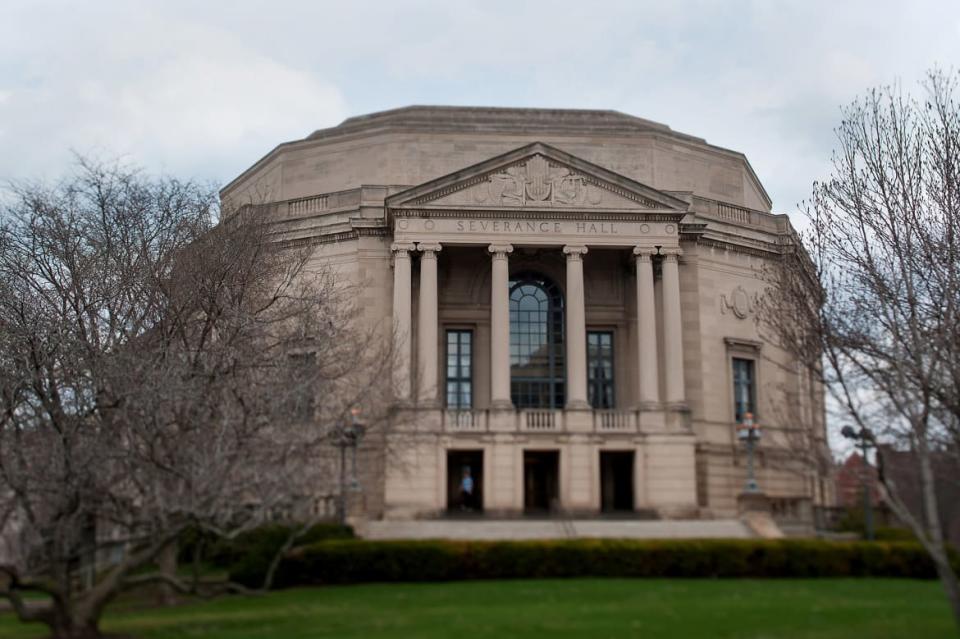
Cleveland’s downtown and University Circle neighborhoods are lined with buildings that mark the battle between the on-its-way-out Beaux-Arts and the rise of a new American architecture coming out of the Midwest best articulated by Louis Sullivan.
But nowhere marks this battle better than the most unlikely of places—the same Lake View Cemetery with the Garfield Memorial that brought me here in the first place. Its mausoleums and gravestones run the gamut from stereotypical neoclassical to art deco to ultra modern. While popular this time of year for its blooms (including the 100,000 plug blooms on Daffodil Hill), the cemetery is a nerd’s heaven. Taking one of the tours offered by the cemetery is a Wikipedia rabbit hole in real time of oft-forgotten tycoons, society dames, politicos, and other notables whose life stories bring the cemetery to, um, life. Elliott Ness is buried there, as is Ray Johnson Chapman (only player to die from an injury in a MLB game when he got hit by Carl Mays in the head), disc jockey Alan Freed (the back of his stone has a jukebox carved in), GOP political boss Mark Hanna, Coburn Haskell (inventor of rubber-core golf ball), and John D. Rockefeller (his 70-foot obelisk is the tallest in the cemetery). Levi Scofield, the architect whose masterpieces dot the city, has a beautiful mausoleum with pink marble columns at the entrance.
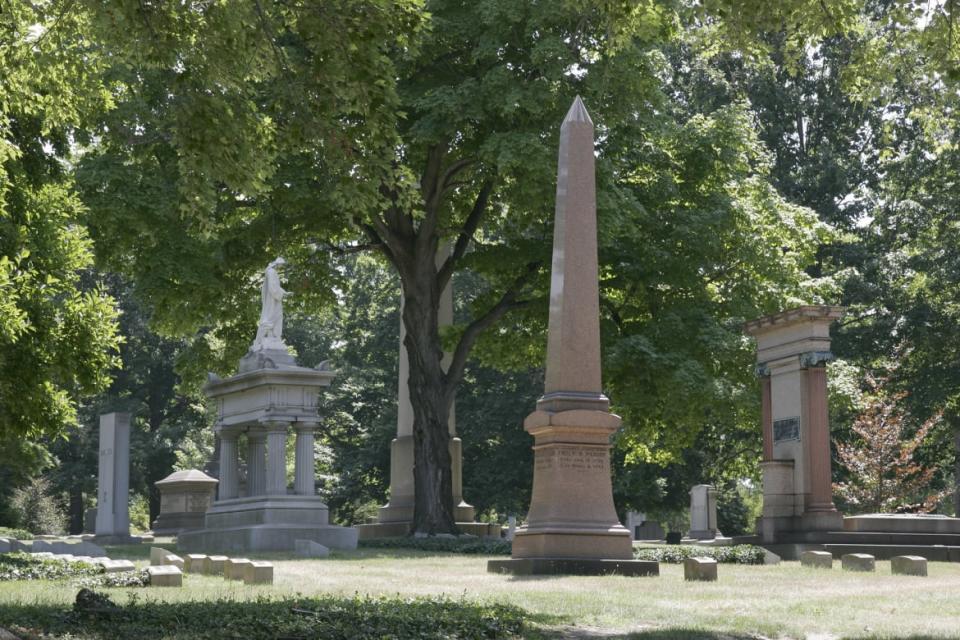
Perhaps the most famous, however, is Wade Memorial Chapel, the non-denominational chapel for industrialist Jeptha Wade decorated inside by Louis Comfort Tiffany in a fish-scale rainbow of glass mosaics depicting biblical scenes. Built in 1901 for $270,000 (millions today, if you could find the artisans) it’s still operational for both weddings and funerals.
But I was there, of course, for Garfield. His memorial was constructed in 1890, nine years after his assassination. It was funded by donations from around the country ($225,000) in total and a competition overseen by local industrialists (as Garfield was from the area), including Rockefeller, selected George Keller of Connecticut’s entry for the design. The interior is eclectic Victorian Gothic to the max, with Druid symbols stenciled and mosaic-ed here and there, a Byzantine-esque gold ceiling made from Murano glass, and stained-glass windows (when Tiffany’s bid was too high, they went with H. Walter Lonsdale, of Mount Stuart House fame, in London). Numidian marble from Morocco, red granite from Nova Scotia, and blue Belgian marble round out the space’s opulence. And of course there is the statue itself, standing 6’9” in white Carrara marble (it was the second attempt as in the first block a flaw was found partway through). The real Garfield stood at six foot, 200 pounds and was a former wrestler. My favorite nugget about his bio? While in college at Williams he dated three women simultaneously!
Now, he’s laid to rest in the vault beneath his grand statue in a marble sarcophagus next to that of his wife (who was also his former student). In the first year he was first placed there, according to the docent, 690,000 people visited. Today, if you go (open from April 1-November 19), you might just have the place to yourself. And if you venture up the spiral staircase to the balcony you will have on a clear day the best view of this truly American city one can find.

